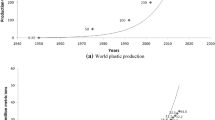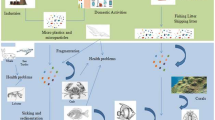Abstract
Experimentally determined octanol–air partition coefficients (K OA) for 43 polychlorinated naphthalene (PCN) congeners and experimentally determined subcooled liquid vapor pressures (P L) for 17 PCN congeners were used with comparative molecular field analysis (CoMFA) and comparative molecular similarity indices analysis (CoMSIA) to generate three-dimensional quantitative structure–activity relationship (3D–QSAR) models. The data were used to predict K OA values for the other 32 congeners and P L values for the other 58 congeners. The CoMFA and CoMSIA model contour maps showed that the electrostatic fields of the PCN molecules are the most important factors affecting the K OA and P L values. The long-range transport potentials of several PCN homologs were assessed using the following grading system: high mobility (MoCNs), relatively high mobility (DiCNs to TeCNs), relatively low mobility (PeCNs to HeCNs) and low mobility (HeCNs and OCN). The PCN-2 molecule was modified using the contour maps of the two models, and the results showed that introducing an electronegative R1 substituent increased the K OA value but introducing an electropositive R6 substituent decreased the P L value. PCN-2 was in the high mobility class, but introducing these substituents moved the long-range transport potentials of the modified molecules to the relatively high mobility class.







Similar content being viewed by others
References
Canada Environment (2011) Ecological screening assessment polychlorinated naphththalenes. Se- condary ecological screening assessment polychlorinated naphththalenes. Available at http: //www.ec.gc.ca/ese-ees/835522FE-AE6C-405A-A729-7BC4B7C794BF/CNs_SAR_En.pdf
Cesar NP, Chiappero MS, Montejano HA (2015) Measurements of octanol-air partition coefficients, vapor pressures and vaporization enthalpies of the (E) and (Z) isomers of the 2-ethylhexyl 4-methoxycinnamate as parameters of environmental impact assessment. Chemosphere 138:546–552
Chayawan V (2015) Externally predictive single-descriptor based QSPRs for physico-chemical properties of polychlorinated-naphthalenes: Exploring relationships of logS W, logK OA, and logK OW with electron-correlation. Hazard Mater 296:68–81
Chen JW, Yang P, Chen S et al (2003) Quantitative structure-property relationships for vapor pressures of polybrominated diphenyl ethers. Sar & Qsar in Environmental Research 14(2):91–111
Chen Y, Cai XY, Jiang L (2016) Prediction of octanol-air partition coefficients for polychlorinated biphenyls (PCBs) using 3D-QSAR models. Ecotoxicol Environ Saf 124:202–212
Clark DR, Fox PC (2004) Statistical variation in progressive scrambling. J Comput Aided Mol Des 18:563–576
Cramer RD, Patterson DE, Bunce JD (1988) Comparative molecular field analysis (CoMFA) effect of shape on binding of steroids to carrier proteins. Am Chem Soc 110(18):5959–5967
Crippen GM (1980) Quantitative structure-activity relationships by distance geometry: Systematic analysis of dihydrofolate reductase inhibitors. J Med Chem 23(6):599–606
Elaine F, da Cunha F, Sippl W et al (2009) 3D-QSAR CoMFA/CoMSIA models based on theoretical active conformers of HOE/BAY-793 analogs derived from HIV-1 protease inhibitor complexes. Eur J Med Chem 44:4344–4352
Finizio A, Mackay D, Bidleman T et al (1997) Octanol-air partition coefficient as a predictor of partitioning of semi-volatile organic chemicals to aerosols. Atmos Environ 31(15):2289–2296
Golbraikh A, Tropsha A (2002) Beware of q2 ! Mol Graph Modell 20:269–276
Gu W, Chen Y, Zhang L, Yu L (2016) Prediction of octanol-water partition coefficient for polychlorinated naphthalenes through three-dimensional QSAR models. Hum Ecol Risk Assess 0:1–16
Halsall CJ, Sweetman AJ, Barrie LA et al (2001) Modelling the behaviour of PAHs during atmospheric transport from the UK to the Arctic. Atmos Environ 35(2):255–267
Harner T, Kylin H, Bidleman TF, Halsall C, Barrie LA, Strachan WMJ (1998) Polychlorinated naphthalenes and coplanar polychlorinated biphenyls in arctic air. Environ Sci Technol 32:3257–3265
Helm PA, Bidleman TF (2005) Gas-particle partitioning of polychlorinated naphthalenes and non- and mono-ortho-substituted polychlorinated biphenyls in arctic air. Sci Total Environ 342:161–173
Helm PA, Bidleman TF, Li HH, Fellin P (2004) Seasonal and spatial variations of polychlorinated naphthalenes and planar polychlorinated biphenyls in arctic air. Environ Sci Technol 38:5514–5521
Herbert BNJ, Halsall CJ, Villa S, Fitzpatrick L, Jones KC, Lee RGM et al (2005) Polychlorinated naphthalenes in air and snow in the Norwegian Arctic: A local source or an eastern Arctic phenomenon? Environ Sci Technol 342:145–160
Huang J, Yu G, Yamauchi M et al (2015) Congener-specific analysis of polychlorinated naphthalenes (PCNs) in the major Chinese technical PCB formulation from a stored Chinese electrical capacitor. Environ Sci Pollut Res 22:14471. doi:10.1007/s11356-014-3677-y
Hung H, Katsoyiannis AA et al (2016) Temporal trends of persistent organic pollutants (POPs) in arctic air: 20 years of monitoring under Arctic monitoring and assessment Programme (AMAP). Environmental Pollutant 217:52–61
Hu Zongqiu (1999) Some chemical properties of covalent compounds characterized by bond energy. Org Chem 19:610–615 (in Chinese)
Hu Zongqiu, Chen Qiong (1999) Study on molecular orbital theory of bond energy IV. Bond energy characterization of stability of covalent compounds[J]. J Wuhan Univ (Nat. Sci. Ed.) 45(4):445–448 (in Chinese)
Jensen, F (2007) Introduction to Computational Chemistry, 2nd ed. John Wiley & Sons Ltd., Chichester, p. 105, pp 380–381
Jiang L, Li Y (2016) Modification of PBDEs (BDE-15, BDE-47, BDE-85 and BDE-126) biological toxicity, bio-concentration, persistence and atmospheric long-range transport potential based on the pharmacophore modeling assistant with the full factor experimental design. Hazard Mater 307:202–212
Khabeev NS, Shagapov VS, Yumagulova YA et al (2015) Evolution of vapor pressure at contact with liquid. Acta Astronautica 114:147–151
Klebe G, Abraham U, Mietzner T (1994) Molecular similarity indices in a comparative analysis (CoMSIA) of drug molecules to correlate and predict their biological activity. J Med Chem 37(24):4130–4146
Kömp P, McLachlan MS (1997) Octanol/air partitioning of polychlorinated biphenyls. Environ Toxicol Chem 16(12):2433–2437
Lee SC, Harner T, Pozo K, Shoeib M, Wania F, Muir DCG et al (2007) Polychlorinated naphthalenes in the global atmospheric passive sampling (GAPS) study. Environ Sci Technol 41:2680–2687
Liu G, Zhang J (2016) Distributions, profiles and formation mechanisms of polychlori- nated naphthalenes in cement kilns co-processing municipal waste incinerator fly ash. Chemosphere 155:348–357
LV Y, Chunsheng YIN, Hongyan LIU, Zhongsheng YI, Yang WANG (2008) 3D-QSAR study on atmospheric half-lives of POPs using CoMFA and CoMSIA. Journal of Environmental Science 20:1433–1438
Mustafa O, Cetin B (2012) Determination of octanol-air partition coefficients of organochlorine pesticides (OCPs) as a function of temperature: Application to air-soil exchange. J Environ Manag 113:432–439
Odabasi M, Cetin E, Sofuoglu A (2006) Determination of octanol/air partition coefficients and super cooled liquid vapor pressures of PAHs as a function of temperature: Application to gas/particle partitioning in an urban atmosphere. Atmos Environ 40(4):6615–6625
Puzyn T, Falandysz J (2005) Computational estimation of logarithm of n-octanol/air partition coefficient and subcooled vapor pressures of 75 chloronaphthalene congeners. Atmos Environ 39:1439–1446
Puzyn T, Falandysz J (2007) QSPR modeling of partition coefficients and Henry’s law constants for 75 Chloronaphthalene congeners by means of six Chemometric approaches―a comparative study. J Phys Chem Ref Data 36:203–214
Radonic J, Vojinovic P, Miloradov M, Turk Sekulic M, Kiurski J, Djogo M, Milovanovic D (2011) The octanol-air partition coefficient, KOA, as a predictor of gas–particle partitioning of polycyclic aromatic hydrocarbons and polychlorinated biphenyls at industrial and urban sites. J Serb Chem Soc 76:447–458
Terry FB, Helm PA et al (2010) Polychlorinated naphthalenes in polar environments-a review. Sci Total Environ 408:2919–2935
Treves K, Shragina L, Rudich Y (2001) Measurement of octanol-air partition coefficients using solid-phase microextraction (SPME)-application to hydroxy alkyl nitrates. Atmos Environ 35(33):5843–5854
Wania F, Mackay D (1996) Tracking the distribution of persistent organic pollutants. Environ Sci Technol 30:390A–396A
Wania F, McLachlan MS (2001) Estimating the influence of forests on the overall fate of semivolatile organic compounds using a multimedia fate model. Environ Sci Technol 35:582–590
Yamamoto T, Noma Y, Sakai S (2016) Thermal destruction of wastes containing polychlorinated naphthalenes in an industrial waste incinerator. Environ Sci Pollut Res. doi:10.1007/s11356-016- 7100-8
Author information
Authors and Affiliations
Corresponding author
Ethics declarations
Funding
This research was supported by the Fundamental Research Funds for the Central Universities in 2013 (grant no. JB2013146) and the Key Projects in the National Science & Technology Pillar Program in the Eleventh Five-Year Plan Period (grant no. 2008BAC43B01).
Conflict of interest
The authors declare that they have no conflict of interest.
Additional information
Responsible editor: Marcus Schulz
Rights and permissions
About this article
Cite this article
Wang, X., Gu, W., Guo, E. et al. Assessment of long-range transport potential of polychlorinated Naphthalenes based on three-dimensional QSAR models. Environ Sci Pollut Res 24, 14802–14818 (2017). https://doi.org/10.1007/s11356-017-8967-8
Received:
Accepted:
Published:
Issue Date:
DOI: https://doi.org/10.1007/s11356-017-8967-8




